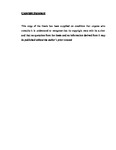The bioavailability and biological effects of nanomaterials towards Escherichia coli: with reference to the soil environment
| dc.contributor.supervisor | Handy, Richard | |
| dc.contributor.author | Vassallo, Joanne | |
| dc.contributor.other | School of Biological and Marine Sciences | en_US |
| dc.date.accessioned | 2018-05-31T13:50:11Z | |
| dc.date.issued | 2018 | |
| dc.date.issued | 2018 | |
| dc.identifier | 10493843 | en_US |
| dc.identifier.uri | http://hdl.handle.net/10026.1/11611 | |
| dc.description.abstract |
Engineered nanomaterials (ENMs) are specifically designed with different functionalities to satisfy required industrial, medical or commercial purposes. The inevitable release of these materials to the environment may impact negatively bacteria that are essential for the ecosystem’s well-being. This work aimed to identify features that determine the hazardous nature of nanomaterials to bacteria. At first, the bacterial growth inhibition concentrations for silver (Ag), cupric oxide (CuO), cadmium telluride quantum dots (CdTe QDs), titanium dioxide (TiO2), nanodiamonds and multi-walled carbon nanotubes were determined on Escherichia coli K-12 MG1655 grown in 96-well plates. The nano-forms of Ag, CuO, TiO2 and the CdTe QDs were found to display more growth inhibitory effects than their bulk equivalents. The metal salts of silver and copper were still more toxic than their equivalent ENM forms; on the contrary the CdTe QDs were found to be more toxic than their metal salts equivalent. The surface coatings of the ENMs were not found to be significant contributors of bacterial growth inhibition. This screening assay could be adapted as a first tier approach; providing an early input into the hazard assessment of nanomaterials to bacteria. The upscale determination of bacterial growth inhibition tests in 250 ml Erlenmeyer flasks manifested similar results to those observed in 96-well plates. The growth inhibition tests with E. coli were also conducted in an anaerobic fermentative environment. The presence of the ENMs was not found to disrupt the functionality of the fermentation respiratory pathway of the bacterium. However, the results indicated a more severe bacterial growth inhibition response to the presence of silver, copper and the cadmium/tellurium based ENMs as compared to the aerobic growth exposures. Finally, from the adaptation of a human ingestion simulation of soil containing CuO NPs, no greater concerns of metal bioaccessibility were identified from the potential ingestion of the nano-forms of CuO versus the metal salt. | en_US |
| dc.language.iso | en | |
| dc.publisher | University of Plymouth | |
| dc.subject | Bacteria | |
| dc.subject | Microbes | |
| dc.subject | Soil | |
| dc.subject | Metals | |
| dc.subject | Quantum | |
| dc.subject | Dots | |
| dc.subject | Toxicity | |
| dc.subject | Nanomaterials | en_US |
| dc.subject.classification | PhD | en_US |
| dc.title | The bioavailability and biological effects of nanomaterials towards Escherichia coli: with reference to the soil environment | en_US |
| dc.type | Thesis | |
| plymouth.version | publishable | en_US |
| dc.identifier.doi | http://dx.doi.org/10.24382/1227 | |
| dc.rights.embargodate | 2019-05-31T00:00:00Z | |
| dc.rights.embargoperiod | 12 months | en_US |
| dc.type.qualification | Doctorate | en_US |
| rioxxterms.funder | Seventh Framework Programme | en_US |
| rioxxterms.identifier.project | NANOSOLUTIONS project | en_US |
| rioxxterms.version | NA |
Files in this item
This item appears in the following Collection(s)
-
01 Research Theses Main Collection
Research Theses Main


